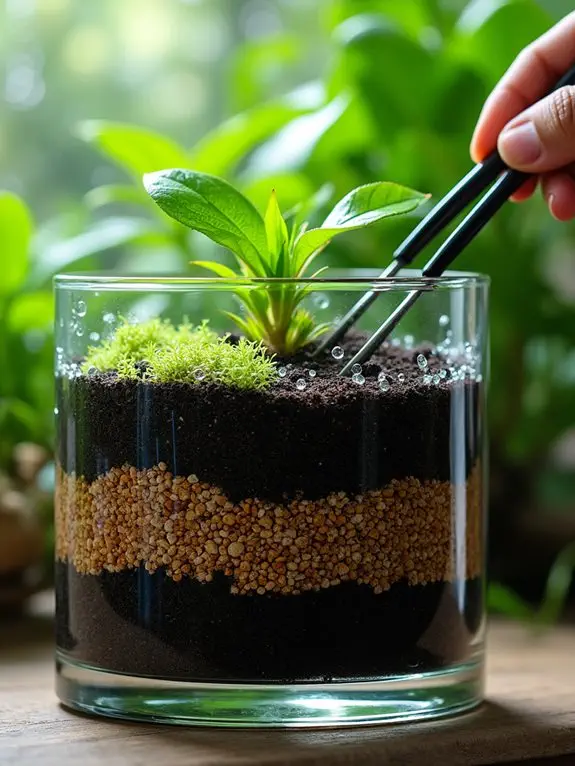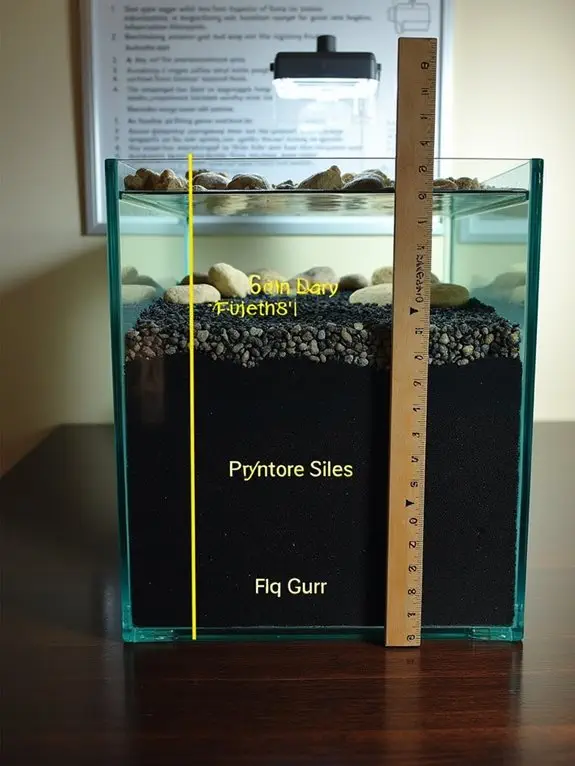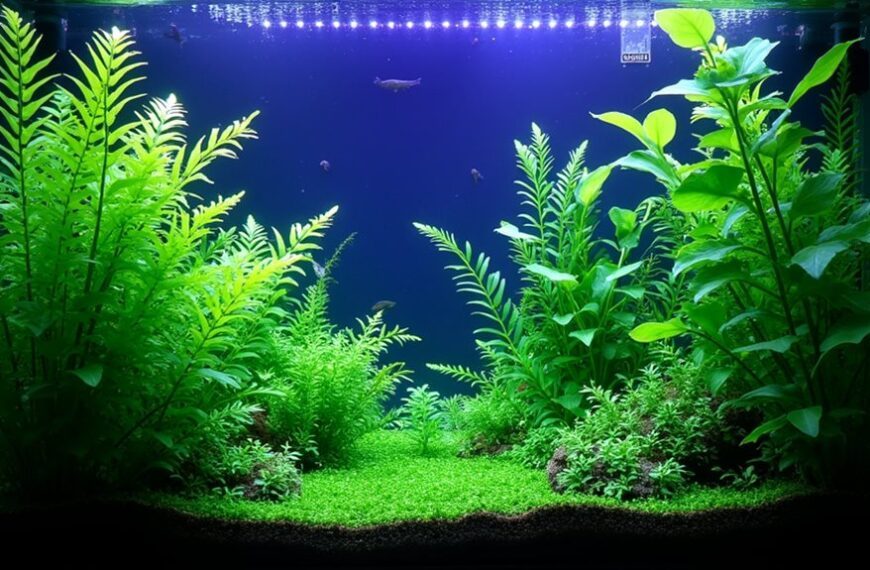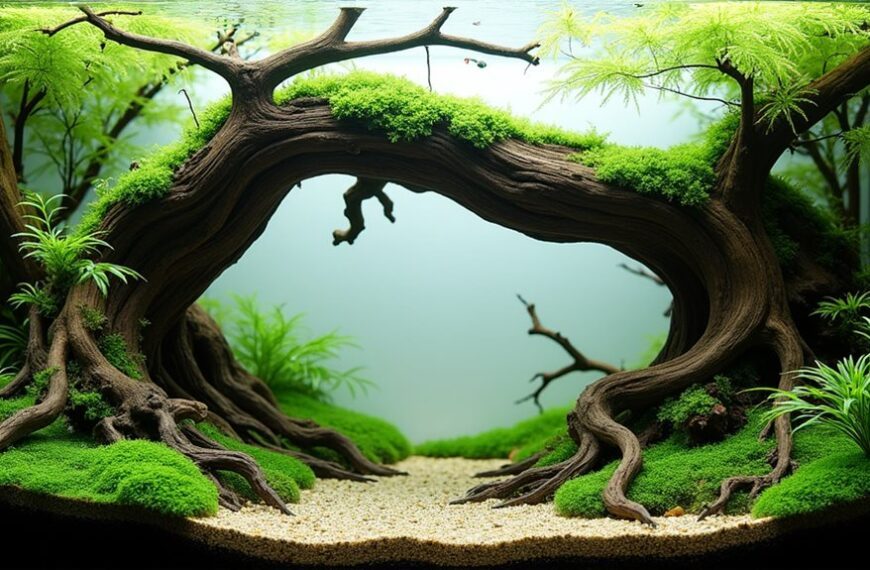To layer aquarium substrate like a pro, start with a 1-inch base layer of nutrient-rich soil or clay. Add a middle layer of mixed substrate (about 1-inch thick) for beneficial bacteria. Finish with a 1-inch decorative top layer of sand or gravel that complements your fish colors. Use simple tools like measuring cups and rulers to guarantee proper depth. For planted tanks, slope the substrate higher in the back. Your fish will thank you as their colors pop against your perfectly layered underwater landscape.
Contents
- 1 Understanding Different Types of Aquarium Substrates
- 2 Essential Tools for Perfect Substrate Layering
- 3 Base Layer Selection and Preparation
- 4 Adding Nutrient-Rich Substrate for Plant Growth
- 5 Proper Techniques for Creating Middle Layers
- 6 Selecting the Ideal Top Layer for Your Aquatic Environment
- 7 Substrate Depth Guidelines for Various Tank Sizes
- 8 Maintaining Layered Substrate Structure Over Time
- 9 Frequently Asked Questions
- 10 Final Thoughts
Understanding Different Types of Aquarium Substrates
Substrate, the foundation of your aquatic world, isn’t just a pretty detail in your tank—it’s essential for your fish’s health and happiness.
When setting up your aquarium, you’ll encounter various substrate options, each serving different purposes for your underwater ecosystem.
Gravel provides excellent water circulation while sand creates a natural look that many bottom-dwellers love.
Specialized planted substrates, rich in nutrients, support aquatic flora by providing essential minerals and maintaining proper substrate chemistry.
Soil-based options work wonders for heavily planted tanks but require careful management.
You’ll want to take into account your specific tank inhabitants before deciding—some fish love to dig, while others prefer smooth surfaces.
Remember that your substrate choice affects everything from water parameters to the success of your plants! Furthermore, the right substrate can significantly influence water chemistry, ensuring a balanced environment for all tank inhabitants.
Essential Tools for Perfect Substrate Layering
When you’re ready to layer your aquarium substrate, having the right tools can make all the difference.
You’ll want to grab precision substrate scoopers to place materials exactly where you need them, dividers and barriers to keep different substrate types separated, and depth measuring tools to guarantee consistent thickness throughout your tank.
These essential tools will help you create that professional-looking aquascape you’ve been dreaming about, with clear boundaries and perfectly proportioned layers.
Precision Substrate Scoopers
Despite what many aquarium blogs might claim, “precision substrate scoopers” don’t actually exist as specialized tools for aquarists! Instead, you’ll find that common household items work perfectly for mastering precision substrate techniques. A clean measuring cup, tablespoon, or even a plastic cup with the bottom cut off can help you carefully place different substrate layers.
When implementing substrate layering benefits, you don’t need fancy equipment—just steady hands and patience! A small plastic container or clean yogurt cup gives you amazing control when adding nutrient-rich base layers without disturbing decorative top layers.
Dividers and Barriers
Just like those improvised scooping tools, you’ll find that “dividers and barriers” for aquarium substrate aren’t fancy commercial products either! Common household items make perfect dividers when creating distinct substrate sections in your tank.
Plastic divider types include cut-up report covers, old food containers, or even plastic playing cards.
Looking for barrier materials that’ll keep different substrates from mixing? Try thin acrylic sheets, plastic mesh, or even filter sponges cut to size.
You’ll want something that’s aquarium-safe and won’t leach chemicals into your water. Simply place your chosen divider where you want separation, add substrates on either side, and then gently remove it once everything’s in place.
This simple trick creates those eye-catching substrate separations that’ll make your friends wonder how you did it!
Depth Measuring Tools
Measuring tools might seem unnecessary for aquarium substrate, but they’re actually game-changers for achieving that perfect setup!
When you’re layering different materials, knowing the exact depth of each layer guarantees proper root growth for plants and adequate space for beneficial bacteria.
You don’t need fancy equipment for effective substrate depth analysis. A simple plastic ruler marked with waterproof tape works wonderfully, or try using a clear tube marked with measurements that you can press into the substrate.
Some aquarists even repurpose kitchen measuring spoons for smaller areas or precise corners!
Good depth measurement techniques prevent common issues like anaerobic pockets or insufficient nutrition layers.
Aim for 1-2 inches for decorative top layers and 2-3 inches for nutrient-rich bottom layers.
Your fish won’t thank you verbally, but they’ll show their appreciation through vibrant health!
Base Layer Selection and Preparation
The foundation of every thriving aquarium begins with selecting the right base layer for your substrate.
You’ll want to choose materials that provide essential base layer benefits, like proper drainage and nutrient storage. Consider options such as nutrient-rich soil, laterite, or specialized aquarium clay—each offering unique advantages for plant growth and biological filtration.
Before adding your base layer, proper substrate preparation is vital.
Rinse your chosen material thoroughly to remove dust and debris that could cloud your water. For soil-based substrates, you might need to mineralize them first by soaking and drying several times to prevent ammonia spikes.
Adding Nutrient-Rich Substrate for Plant Growth

Once your base layer is in place, adding nutrient-rich substrate becomes the crucial next step for creating a thriving underwater garden. This middle layer provides essential nutrient sources that your aquatic plants will tap into as they establish their root systems.
Choose substrate specifically designed for planted tanks—look for options containing iron, potassium, and nitrogen. You’ll want to reflect on plant compatibility when selecting your nutrient mix; different plants have varying nutritional needs.
Spread this layer about 1-2 inches thick, sloping it slightly higher toward the back for depth perspective.
Don’t worry if you’re not a botanist! Most commercially available planted tank substrates take the guesswork out of the equation. Your plants will thank you with vibrant growth, and you’ll enjoy fewer algae problems as plants outcompete these unwanted guests for nutrients.
Proper Techniques for Creating Middle Layers
When creating your aquarium’s middle substrate layers, you’ll want to mix your nutrients evenly throughout to promote healthy root development and prevent dead zones.
The consistency of your sand matters greatly—aim for medium-grain varieties that allow water circulation while preventing compaction that could harm beneficial bacteria.
You’re fundamentally establishing distinct biological zones where helpful microorganisms can thrive, creating a natural filtration system that will support your aquatic ecosystem for years to come.
Mixing Nutrients Effectively
Creating a nutrient-rich middle layer forms the backbone of any thriving planted aquarium. When mixing your nutrients, aim for an even distribution throughout your substrate to maximize nutrient absorption by plant roots.
You’ll want to combine high-quality aquarium soil with mineral supplements like iron, potassium, and trace elements that promote lush growth.
Don’t just dump everything in haphazardly! Instead, use your hands to gently fold the nutrients into your substrate material, ensuring consistent substrate interaction without creating dense pockets that could lead to anaerobic conditions.
Think of it like mixing cookie dough—you want everything well incorporated but not overmixed.
Sand Consistency Matters
The middle layer’s composition hinges significantly on sand consistency throughout your aquarium substrate. When you’re building this layer, pay close attention to sand texture—it’s not just about looking pretty! Fine sand packs too tightly and restricts water flow, while coarse sand allows beneficial bacteria to thrive.
You’ll want to aim for medium-grain sand that strikes the perfect balance.
Don’t overlook substrate color either. Darker sands make fish colors pop (especially those red and blue species you’ve been eyeing), while lighter sands brighten the entire tank.
Remember, your substrate isn’t just functional—it’s the canvas for your underwater masterpiece!
Mix your sand thoroughly before adding it, removing any clumps that might create dead zones. Trust me, your fish will thank you for taking the time to get this middle layer just right!
Establish Biological Zones
Establishing biological zones within your middle substrate layer determines how successfully your aquarium ecosystem will function.
Think of this layer as your tank’s processing center, where beneficial bacteria colonize and create a natural filtration system that keeps your fish healthy. You’ll want to use substrate materials that provide plenty of surface area—like porous ceramic rings or specialized bio-media—where these microscopic heroes can set up shop.
Don’t skimp on this critical middle zone! When you create the right environment for these bacteria, they’ll reward you by breaking down toxic ammonia and nitrites.
It’s like having thousands of tiny janitors working 24/7 in your tank. Layer these materials carefully, ensuring water can flow through without creating dead spots.
Your fish will thank you later with their vibrant colors and active swimming—a clear sign your biological zones are thriving!
Selecting the Ideal Top Layer for Your Aquatic Environment
Selecting your top substrate layer might seem overwhelming at first, but it’s actually where you’ll have the most fun expressing your aquarium’s personality.
The substrate color you choose will dramatically impact your tank’s overall appearance, creating either a vibrant showcase or a natural underwater scene.
When considering layering aesthetics, think about what’ll complement your fish and plants.
Dark substrates make colorful fish pop, while lighter sands create a bright, airy feel.
You’re not just building a home for aquatic life—you’re creating a living artwork!
Substrate Depth Guidelines for Various Tank Sizes

Proper substrate depth varies considerably depending on your aquarium’s size and purpose.
For nano tanks (under 10 gallons), you’ll want just 1-1.5 inches of substrate, while medium tanks (10-40 gallons) benefit from 1.5-2 inches.
Larger aquariums (40+ gallons) can handle 2-3 inches comfortably.
Consider substrate color carefully—darker substrates make fish colors pop but show debris more easily.
Lighter substrate creates a brighter tank but may wash out some fish colors.
The substrate texture matters too! Fine-grained substrates work better for bottom-dwelling fish that like to dig, while coarser options provide better water flow.
Maintaining Layered Substrate Structure Over Time
Once you’ve created the perfect layered substrate for your aquarium, you’ll need to keep it that way. Long-term stability depends on how you handle everyday tank maintenance. Your careful setup can quickly become mixed if you’re not mindful during cleaning sessions.
Mindful maintenance is the secret to preserving your perfectly layered aquarium substrate for the long term.
For ideal substrate maintenance tips, follow these practices:
- Use a gentle touch when vacuuming—hover slightly above the substrate rather than digging in.
- Plant root-feeding species to help hold layers in place naturally.
- Add new substrate on top rather than mixing when replenishing.
- Clean filter intakes regularly to prevent strong currents that disturb bottom layers.
You’ll find that with these simple precautions, your beautifully layered substrate can maintain its structure for years, providing consistent benefits to your underwater community.
Frequently Asked Questions
Can I Change Substrate Layers in an Established Tank?
Yes, you can change substrate layers in your established tank. Using proper substrate replacement techniques guarantees tank ecosystem stability. You’ll need to move fish, save some water, and reintroduce beneficial bacteria during the process.
How Does Substrate Layering Affect Water Ph?
Your substrate composition directly impacts water chemistry. Certain materials like crushed coral raise pH, while others like driftwood lower it. You’ll want to choose layers strategically based on your fish’s preferred pH requirements.
Should I Rinse All Substrate Types Before Layering?
Yes, you should rinse most substrate types before layering to remove dust and contaminants. However, some specialized substrates like aquasoil shouldn’t be rinsed as it’ll wash away nutrients essential for your layering techniques.
Can I Mix Different Colored Substrates Within Layers?
Yes, you can mix different colored substrates within layers! It’s a great way to create unique color combinations and boost your tank’s aesthetic appeal. You’ll achieve interesting patterns that make your aquarium visually distinctive.
How Do Substrate Layers Impact Beneficial Bacteria Colonization?
Substrate layers affect where bacterial colonies form. Coarser substrate types provide more surface area for beneficial bacteria, while compacted layers may restrict oxygen. You’ll want porous materials throughout for ideal biological filtration.
Final Thoughts
You’ve now mastered the art of layering aquarium substrate like a pro! With your newfound knowledge about choosing the right materials, creating purposeful layers, and maintaining your setup, you’ll create a thriving underwater ecosystem that both you and your aquatic friends will love. Remember, proper substrate layering isn’t just about aesthetics—it’s the foundation for a healthy, balanced tank that’ll reward you with years of enjoyment.












